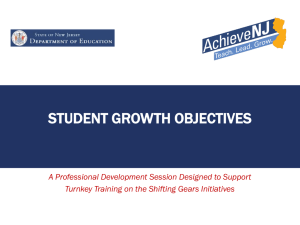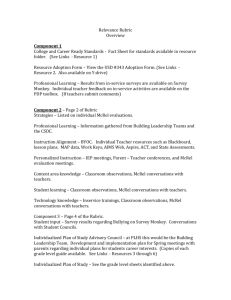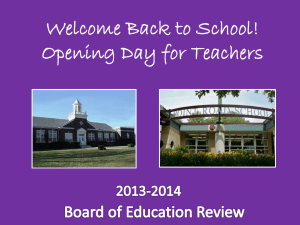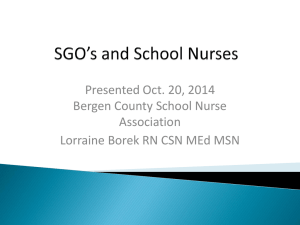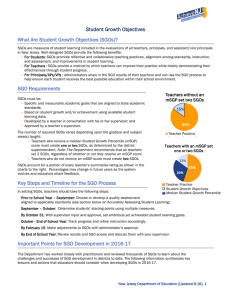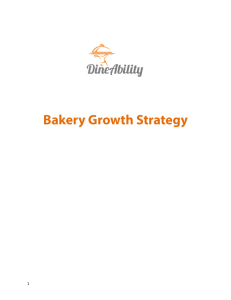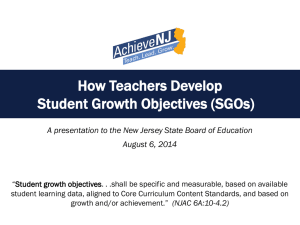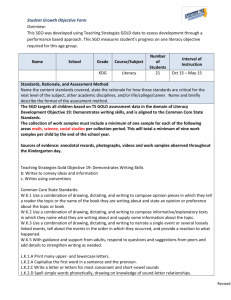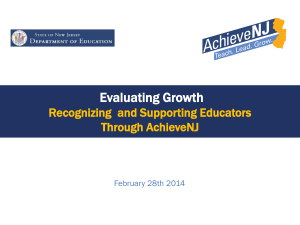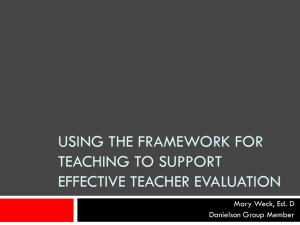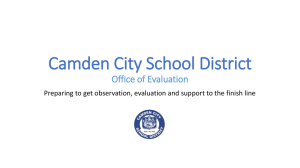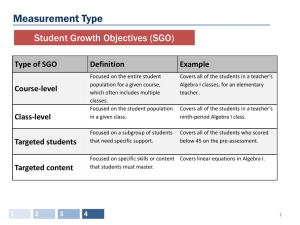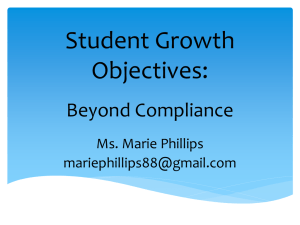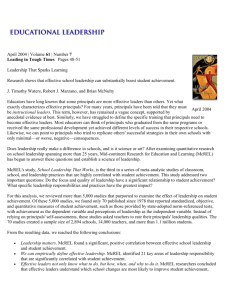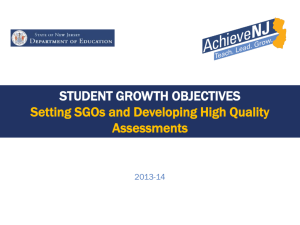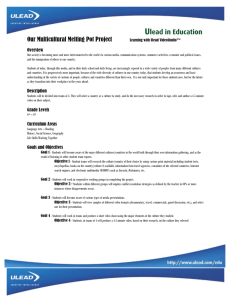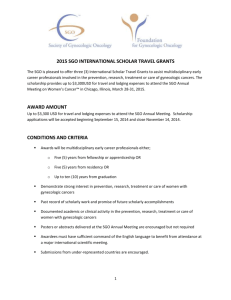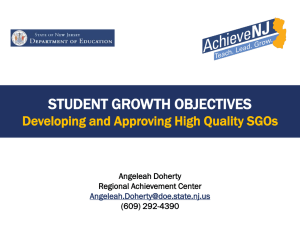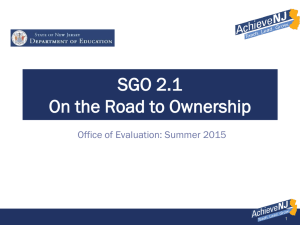McRel Teacher Evaluation PowerPoint
advertisement
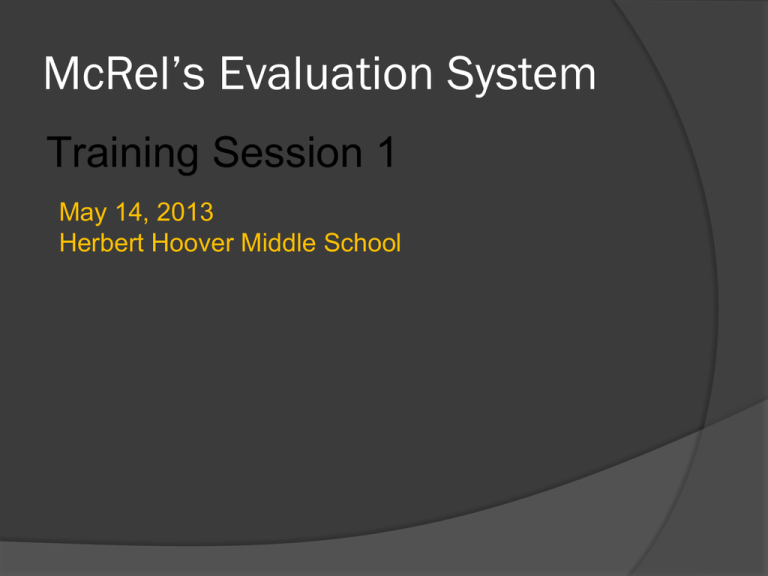
McRel’s Evaluation System Training Session 1 May 14, 2013 Herbert Hoover Middle School What is an SGP? Student Growth Percentiles (SGPs) measure achievement gains within 4th through 8th grade Language Arts Literacy and Mathematics, referred to as the “tested grades and subjects.” Using the New Jersey Assessment of Skills and Knowledge (NJ ASK), SGPs compare the change in a student’s achievement from one year to the next to that of all other students in the state who had similar historical results (the student’s “academic peers”). For teachers of tested grades and subjects, SGP counts for 30 percent of the overall evaluation rating. What is an SGO Student Growth Objectives (SGOs) for their students at the start of the year and are assessed on whether those objectives are met at the end of the year. These are district-developed assessments and should be used where available to identify the measurable goals for each objective. Teachers also may use collaboratively developed assessments for SGOs, including portfolios of student work. Teachers of non-tested grades and subjects are required to set at least two SGOs; a teacher’s ability to meet or exceed his or her SGOs counts for 15 percent of the overall evaluation. Teachers of tested grades and subjects are required to set at least one SGO; a teacher’s ability to meet or exceed his or her SGO(s) counts for 15 percent of the overall evaluation. 80 % of Teachers 20 % of Teachers Tested Areas What is McRel’s Teacher Evaluation System? Purposes Measure the performance of individual teachers and administrators. Guide teachers as they reflect upon their effectiveness. Serve as the basis for instructional improvement. Focus the goals and objectives of school and district as they support, monitor, and evaluate their teachers. Guide school and district professional development Facilitate a collaborative culture with focus on continuous improvement. Shannon McRel’s Teacher Evaluation System Teacher Orientation Professional Development Plan Teacher SelfAssessment Summary Evaluation Conference and Summary Rating Form PostObservation Conference Pre-Observation Conference Observations Shannon What does this mean for Hoover teachers? next year you will have same number of observations as this year as per contract - Tenured teachers – one Non-tenured teachers - three you will have to do a self-evaluation by June 14th you will have a pre-conference and a postconference for the 2013-2014 school year Wendy What is the “Self-Assessment"? • • • Using the online assessment, reflect on personal performance over the past year to this point in the school year. Fill out the assessment based on your performance. At the end of each section consider: 1. Artifacts or evidence to support your ratings. 2. Fulfillment of leadership responsibilities relating to your school accountability goals. What qualifies as an “artifact?” Concrete proof that a standard has been met Projects Lesson Plans Presentations Comments on paper (feedback!) Professional Development E-mails to parents Parent-call logs Posted classroom expectations Can be uploaded digitally onto McRel’s website (preferred) to provide access to administrator This will be used to support practice Wendy What is a Pre-observation conference? The pre-observation conference is a collaborative meeting between the teacher and his/her supervisor to... discuss the teacher's self-assessment based on the self-evaluation, the most recent professional development plan, the lesson to be observed, and the classroom dynamics provide lesson plans or a written description of the lesson prepare the evaluator for the observation Ken What is a Post-Conference ? • The evaluator will conduct a postobservation conference within 10 days after formal observation. • The evaluator and teacher will discuss and document the strengths and weaknesses of the teacher's performance. Ken What are the Standards? Standard 1 Standard I: Teachers Demonstrate Leadership What does it mean? Lead in the classroom, school and community in an ethical way. Debi Standard 2 Standard II: Teachers establish a Respectful Environment for a Diverse Population of Students What does it mean? Welcoming classroom environment for ALL of your students. Marc Standard 3 Standard III: Teachers Know the Content They Teach What does it mean? Know what you teach and make it relevant for students. Hilary Standard 4 Standard IV: Teachers Facilitate Learning for Their Students What does it mean? Differentiated instruction and a variety of formative and summative assessments. Denise Standard 5 Standard V: Teachers Reflect on Their Practice What does it mean? Analyze students' learning to adjust your teaching, professional development and commitment to professional growth. Debi Elements within the Standards Standard Number of Elements Number of Observable Elements I – Leadership 5 1 II – Classroom Environment 5 4 III – Knowledge of Content 4 4 IV – Facilitate Learning 8 8 V – Reflect on Practice 3 0 Denise Performance Rating Scale Frank This is how we need to start thinking… Distinguished Accomplished Proficient Developing “Distinguished” is a place to visit not to live Frank Year 2 Distinguished Distinguished Year 3 Accomplished Accomplished Year 1 Proficient Proficient Frank Standard on Self Assessment Susan Edison Indicators Susan What is the Teacher Evaluation Rubric? Edison Township is defining the indicators for the elements under each Standard. When we know, you’ll know! The Online Self-Assessment Link • Here is the link for your 2013-2014 Evaluation system: https://ats1.searchsoft.net/ats/emp_login?COMPANY_ID=00018070 • All users will use their email address as their username. Ex: bob.smith@edison.k12.nj.us • All users will have the system default password: 123456

